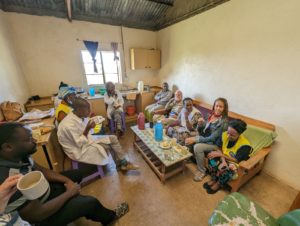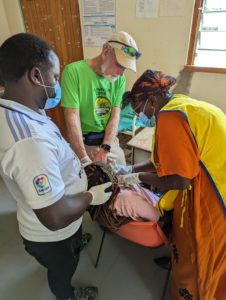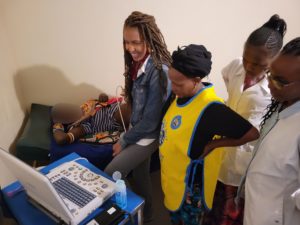
What Does A Mission Look Like?
In less than a week, we’ll be back on the ground in Kenya on a mission, doing what we love: training, educating, and building strong connections in new communities.
If you’ve never joined a mission, you’re probably wondering, what does it look like to be on one of these trips?
Let’s hear from Dr. Glenn Geelhoed, Founder of Mission to Heal, and Sam Jangala, our Director of Operations, on what a week in the life of Mission to Heal is like.
While there is no such thing as a typical week, Mission to Heal follows a basic structure for each location. The wider goals of transformational learning and inspiring local healthcare practitioners are why Dr. Glenn created Mission to Heal, and why it continues to function decades later.
On Mondays, the team of Mission to Heal volunteers and local clinic staff meet to discuss the goals of the week with hospital authorities and government officials. While it doesn’t sound as fun as jumping into operations, this first day is vital for understanding the context of the place where they will work.
 “We work within the constraints of the hospital,” Sam explains. “The goals of the week are all based upon what we agree on with the local staff on that first day. As Mission to Heal, we can’t take our metrics and expectations to different places with varying experiences, budgets, skill, and personnel. We can’t superimpose our specific goals into a particular location.”
“We work within the constraints of the hospital,” Sam explains. “The goals of the week are all based upon what we agree on with the local staff on that first day. As Mission to Heal, we can’t take our metrics and expectations to different places with varying experiences, budgets, skill, and personnel. We can’t superimpose our specific goals into a particular location.”
Teaching begins on Tuesday after the week’s goals have been determined. Mornings start with a tutorial session with the local doctors, nurses, and medical officers who are there to learn. During this tutorial, Dr. Glenn speaks to the group on a topic the trainees have picked. These are often about diseases that healthcare workers come in contact with, or specific surgical skills they want to understand better.
 They then move on to screening patients. This process determines who will be a good candidate for surgery. “Typically, we try to see all types of patients, not just the ones the local hospital thinks are in need of operations,” Sam explains.
They then move on to screening patients. This process determines who will be a good candidate for surgery. “Typically, we try to see all types of patients, not just the ones the local hospital thinks are in need of operations,” Sam explains.
Whether in North America or Africa, the same measures determine who is eligible for an operation. The most important decision for a surgeon is knowing when to operate and when not to. “If a person comes in with a hernia, but also suffers from diabetes and blindness, they are not a good candidate,” Sam says. “However, that judgment is lacking in places where there aren’t experienced surgeons. That’s why we screen patients with local doctors. We teach them the skill of selecting ideal patients so they can truly help them.”
Operations begin in the afternoon after cases have been selected with a local doctor. Sam works to prepare to operate in Mission to Heal’s Mobile Surgical Unit (MSU). “Sometimes, if the local hospital has an operating theater, we go there so local staff are more comfortable with the environment,” he says.

Dr. Glenn’s priority is to not conform to the one-size-fits-all mindset that has found its way into medical missions. He does not want to become the medium through which surgeries are “cranked out”; rather, he teaches willing medical personnel which operations will be most helpful. Sam adds, “We try to not do more than ten operations a day. We are there to teach surgical skills, and we have learned that a maximum of ten each day is a good amount for teaching.”
At the end of the day, they finish operations when the clinic is done with its work day. “We work within the limitations of the hospital and their own timings,” Sam says. “Our hope is to show the hospital that we are not there to tell them what to do, but that we are working within their system. If they have a nine-hour work day, that’s how much we work.”
Fridays are the last day at a particular location. Dr. Glenn holds a longer tutorial session and looks back on the skills everyone has learned that week. The local healthcare workers write out reflections, which helps them think about how they can implement what they have learned for future patient interactions.
“We encourage the clinic or hospital to schedule their own operations on Friday. This way, they can use the skills they’ve learned that week,” Sam says. “Dr. Glenn and other volunteers do sit in the clinic to help select patients, but it’s up to the local staff to determine who gets the operations.” Sam adds that they use the afternoon to assess the successes of the last week. Then, they pack up the trucks and travel to the next location.

So, what makes a mission successful? “Success is not quantified by how many operations we do or the number of patients we see,” Sam says. “It’s about how willing medical staff are to learn new procedures and techniques, and how willing they are to go beyond their comfort zone to have a transformational experience.”
Sam comments that success is based on how well Mission to Heal can improve the environment through teaching. “We hope that they are able to understand that they can do operations themselves and alleviate problems within their community,” he adds.
Mission to Heal sees any willingness to learn as a success. Even if ten people signed up to learn, but only one person stayed through until the end of the week, there is still new knowledge in the community. They know large-scale change starts at a grassroots level. “We partner with locals who will do anything for an education,” Dr. Glenn says. “They have pledged every day to implement what they have learned.”
Help us continue to bring transformational experiences to remote communities around the world.